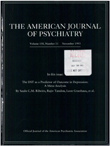Effects of statutes requiring psychiatrists to report suspected sexual abuse of children
Abstract
OBJECTIVE: Reporting of child sexual abuse is mandatory in all 50 states. Conceptual distinctions between privileged communications and mandatory reporting are reviewed, and the impact of recent changes in Maryland's reporting laws is examined. METHOD: Beginning in 1964 Maryland law required reporting if abuse was suspected when a physician examined a child. In 1988 reporting of disclosures by adult patients about child sexual abuse that occurred while they were in treatment was mandated. In 1989 all patient disclosures, even about such abuse that occurred before treatment, became reportable. During the period of statutory changes, the Johns Hopkins Sexual Disorders Clinic had kept track of adult patients who referred themselves for treatment and adult patients' disclosures of child sexual abuse. This allowed analysis of the impact produced by changes in the reporting requirements. RESULTS: 1) Mandatory reporting of disclosures about prior child sexual abuse deterred undetected adult abusers from entering treatment. The rate of self-referrals when such reporting became mandatory in 1989 dropped from approximately seven per year (73 over a 10-year period) to zero. This may have caused some unidentified children to remain at risk. 2) Mandatory reporting deterred patients' disclosures about child sexual abuse that occurred during treatment. In 1988 the disclosure rate during treatment dropped from approximately 21 per year to zero. This deprived clinicians of information important for early intervention. 3) Mandatory reporting failed to increase the number of abused children identified. The number identified secondary to such disclosures was zero. CONCLUSIONS: Optimal protection of children, as well as treatment for adult patients, may be better accomplished by legislation that supports options other than reporting.
Access content
To read the fulltext, please use one of the options below to sign in or purchase access.- Personal login
- Institutional Login
- Sign in via OpenAthens
- Register for access
-
Please login/register if you wish to pair your device and check access availability.
Not a subscriber?
PsychiatryOnline subscription options offer access to the DSM-5 library, books, journals, CME, and patient resources. This all-in-one virtual library provides psychiatrists and mental health professionals with key resources for diagnosis, treatment, research, and professional development.
Need more help? PsychiatryOnline Customer Service may be reached by emailing [email protected] or by calling 800-368-5777 (in the U.S.) or 703-907-7322 (outside the U.S.).



